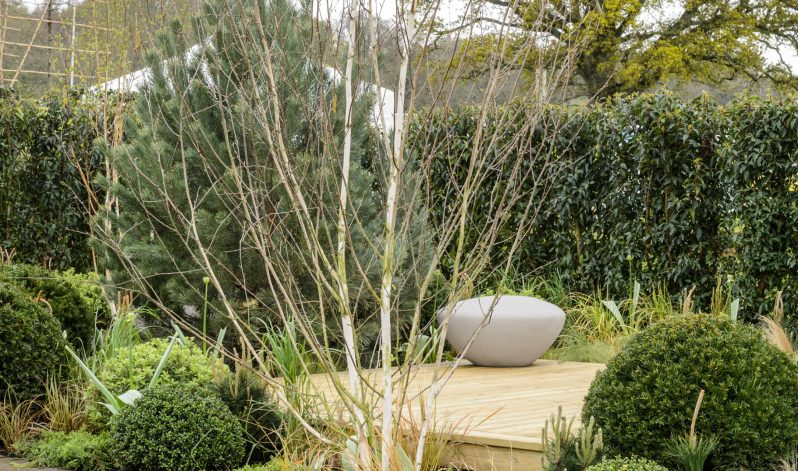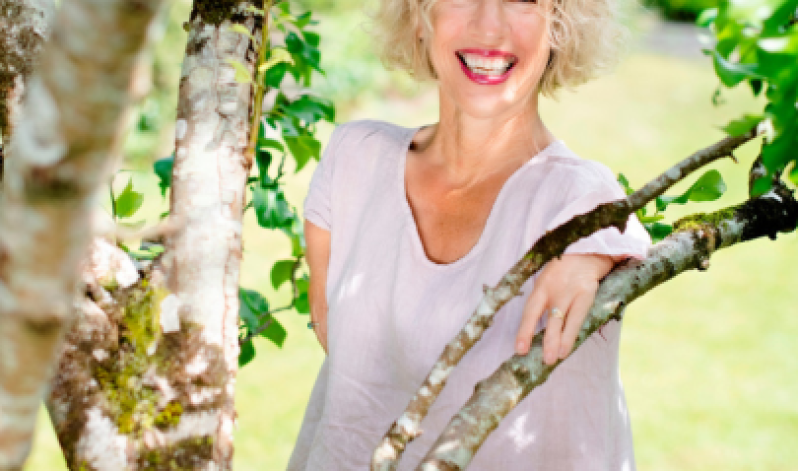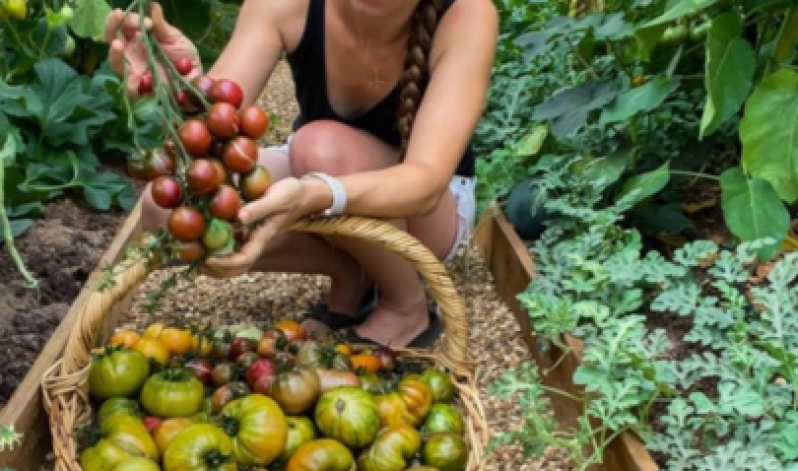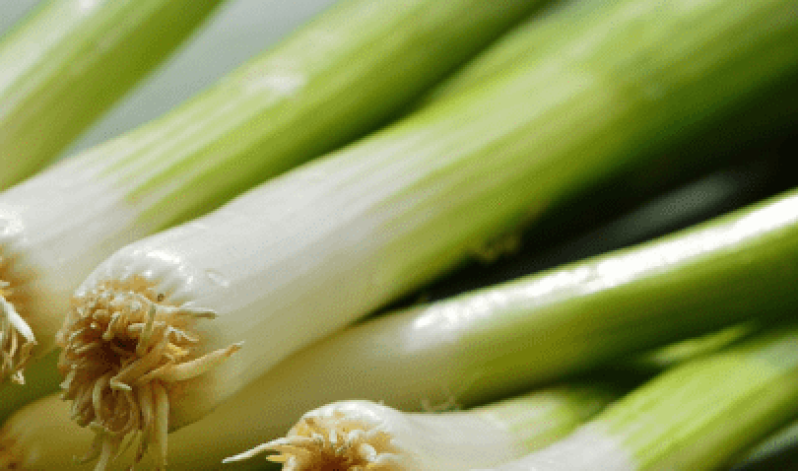Apr 28, 2023
0 comment
The Landscape Service, Furzey Gardens and Kingston Maurward College scoop top Awards at the BBC Gardeners’ World Spring Fair at Beaulieu
BBC TV gardening presenter, Frances Tophill, has presented awards to design teams and horticulture students behind some show-stopping gardens and displays at the BBC Gardeners’ World Spring Fair at Beaulieu today.Winner of the Spring Fair’s Best Showcase Garden and a Platinum Award was Nordic Retreat by The Landscape Service, based in Southampton. Designed by Luke Mills, the stylish, minimalist garden is designed to offer a calming space to relax, unwind and rejuvenate, providing temporary respite from the urban environment. It features neutral colours, planting features to create dappled shade, and natural hard landscaping materials.Best Beautiful Border and Platinum Award winner was ‘Not all those who wander are lost’ by Furzey Gardens and Minstead Trust who provide training and work experience for people with learning disabilities. The Border was inspired by a poem from J.R.R. Tolkien’s The Fellowship of the Ring, and features plants grown at Furzey Gardens, a stepping stone path, and a grand chair carved from the trunk of an old Elm tree.The Beautiful Borders competition is a highlight at all BBC Gardeners’ World Events and is designed to provide achievable inspiration for smaller gardens and tricky spaces. Entrants take on the challenge of packing compact 9m2 plots with imaginative planting and creative design features. This year’s theme is ‘My Garden Escape’. Spring Fair award assessors for the Beautiful Borders were Ian Hodgson, editor of Garden News, and acclaimed Hampshire garden designers, Anita Foy from Anita Foy Garden Design, and Richard Barnard from Kings Oak Landscapes. The Spring Fair’s first ever inter-horticultural college competition was won by students from Kingston Maurward College in Dorset. The college team won Best College Garden and a Platinum Award for A Wardian Garden, a design inspired by the college’s Victorian heritage. Colleges were tasked with designing budget-friendly gardens with a Victorian Garden theme. All the college teams were mentored by award-winning garden designer, Cherry Carmen.Show Assessor Richard Barnard said: “It’s great to have the colleges here at the Spring Fair. The quality of work is excellent and these brilliant students are the future of horticulture.”Reviewing all Award entries at the Spring Fair, BBC TV gardening presenter Frances Tophill, said: “I’m hugely impressed with the talent involved and the hard work that has gone into creating these wonderful gardens and displays, with every award richly deserved. I have no doubt that they will inspire thousands of people over the Spring Fair weekend to try something new or different in their garden, veg patch or window box. Whether you’re new to gardening or a green-fingered expert, it’s a great time of year to make garden plans for the summer ahead. The BBC Gardeners’ World Spring Fair really is the perfect place for ideas to blossom and grow.”
READ THE FULL PRESS RELEASE
/*! elementor-pro - v3.19.0 - 07-02-2024 */
@charset "UTF-8";.entry-content blockquote.elementor-blockquote:not(.alignright):not(.alignleft),.entry-summary blockquote.elementor-blockquote{margin-right:0;margin-left:0}.elementor-widget-blockquote blockquote{margin:0;padding:0;outline:0;font-size:100%;vertical-align:baseline;background:transparent;quotes:none;border:0;font-style:normal;color:#3f444b}.elementor-widget-blockquote blockquote .e-q-footer:after,.elementor-widget-blockquote blockquote .e-q-footer:before,.elementor-widget-blockquote blockquote:after,.elementor-widget-blockquote blockquote:before,.elementor-widget-blockquote blockquote cite:after,.elementor-widget-blockquote blockquote cite:before{content:none}.elementor-blockquote{transition:.3s}.elementor-blockquote__author,.elementor-blockquote__content{margin-bottom:0;font-style:normal}.elementor-blockquote__author{font-weight:700}.elementor-blockquote .e-q-footer{margin-top:12px;display:flex;justify-content:space-between}.elementor-blockquote__tweet-button{display:flex;transition:.3s;color:#1da1f2;align-self:flex-end;line-height:1;position:relative;width:-moz-max-content;width:max-content}.elementor-blockquote__tweet-button:hover{color:#0967a0}.elementor-blockquote__tweet-button span{font-weight:600}.elementor-blockquote__tweet-button i,.elementor-blockquote__tweet-button span{vertical-align:middle}.elementor-blockquote__tweet-button i+span,.elementor-blockquote__tweet-button svg+span{margin-left:.5em}.elementor-blockquote__tweet-button svg{fill:#1da1f2;height:1em;width:1em}.elementor-blockquote__tweet-label{white-space:pre-wrap}.elementor-blockquote--button-skin-bubble .elementor-blockquote__tweet-button,.elementor-blockquote--button-skin-classic .elementor-blockquote__tweet-button{padding:.7em 1.2em;border-radius:100em;background-color:#1da1f2;color:#fff;font-size:15px}.elementor-blockquote--button-skin-bubble .elementor-blockquote__tweet-button:hover,.elementor-blockquote--button-skin-classic .elementor-blockquote__tweet-button:hover{background-color:#0967a0;color:#fff}.elementor-blockquote--button-skin-bubble .elementor-blockquote__tweet-button:hover:before,.elementor-blockquote--button-skin-classic .elementor-blockquote__tweet-button:hover:before{border-right-color:#0967a0}.elementor-blockquote--button-skin-bubble .elementor-blockquote__tweet-button svg,.elementor-blockquote--button-skin-classic .elementor-blockquote__tweet-button svg{fill:#fff;height:1em;width:1em}.elementor-blockquote--button-skin-bubble.elementor-blockquote--button-view-icon .elementor-blockquote__tweet-button,.elementor-blockquote--button-skin-classic.elementor-blockquote--button-view-icon .elementor-blockquote__tweet-button{padding:0;width:2em;height:2em}.elementor-blockquote--button-skin-bubble.elementor-blockquote--button-view-icon .elementor-blockquote__tweet-button i,.elementor-blockquote--button-skin-classic.elementor-blockquote--button-view-icon .elementor-blockquote__tweet-button i{position:absolute;left:50%;top:50%;transform:translate(-50%,-50%)}.elementor-blockquote--button-skin-bubble .elementor-blockquote__tweet-button:before{content:"";border:.5em solid transparent;border-right-color:#1da1f2;position:absolute;left:-.8em;top:50%;transform:translateY(-50%) scaleY(.65);transition:.3s}.elementor-blockquote--button-skin-bubble.elementor-blockquote--align-left .elementor-blockquote__tweet-button:before{right:auto;left:-.8em;border-right-color:#1da1f2;border-left-color:transparent}.elementor-blockquote--button-skin-bubble.elementor-blockquote--align-left .elementor-blockquote__tweet-button:hover:before{border-right-color:#0967a0}.elementor-blockquote--button-skin-bubble.elementor-blockquote--align-right .elementor-blockquote__tweet-button:before{left:auto;right:-.8em;border-right-color:transparent;border-left-color:#1da1f2}.elementor-blockquote--button-skin-bubble.elementor-blockquote--align-right .elementor-blockquote__tweet-button:hover:before{border-left-color:#0967a0}.elementor-blockquote--skin-boxed .elementor-blockquote{background-color:#f9fafa;padding:30px}.elementor-blockquote--skin-border .elementor-blockquote{border-color:#f9fafa;border-left:7px #f9fafa;border-style:solid;padding-left:20px}.elementor-blockquote--skin-quotation .elementor-blockquote:before{content:"“";font-size:100px;color:#f9fafa;font-family:Times New Roman,Times,serif;font-weight:900;line-height:1;display:block;height:.6em}.elementor-blockquote--skin-quotation .elementor-blockquote__content{margin-top:15px}.elementor-blockquote--align-left .elementor-blockquote__content{text-align:left}.elementor-blockquote--align-left .elementor-blockquote .e-q-footer{flex-direction:row}.elementor-blockquote--align-right .elementor-blockquote__content{text-align:right}.elementor-blockquote--align-right .elementor-blockquote .e-q-footer{flex-direction:row-reverse}.elementor-blockquote--align-center .elementor-blockquote{text-align:center}.elementor-blockquote--align-center .elementor-blockquote .e-q-footer,.elementor-blockquote--align-center .elementor-blockquote__author{display:block}.elementor-blockquote--align-center .elementor-blockquote__tweet-button{margin-right:auto;margin-left:auto}
The Nordic Retreat is our first show garden so I couldn’t be happier to have won this award. Inspired by my Nordic heritage, I wanted the garden to have a therapeutic effect, providing calm and respite from busy life. It’s been a real team effort by gardeners, landscapers, suppliers and sponsors, and I’m over the moon.
Luke Mills, Director of The Landscape Service
We are delighted for all the people that we support that have worked so hard to create this garden. It has created a real sense of purpose and shows what people with learning disabilities can achieve when they have support and encouragement.
Andrew Bentley, Estates Manager at Minstead Trust
This garden has brought students together from across the college’s horticultural courses. They’ve done the research, sourced materials and built the garden, all with the support of our tutors. It’s just incredible to have won.
Alison Firth, a Level 3 Horticulture student and designer at Kingston Maurward College





